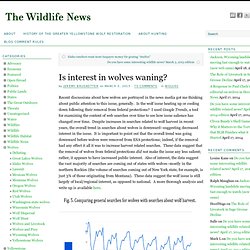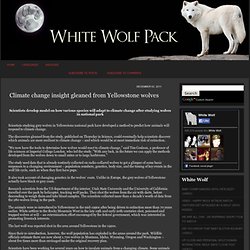

Rare Alaska Wolf One Step Closer to Endangered Species Act Protection. For Immediate Release, September 22, 2014 SITKA, Alaska— The Center for Biological Diversity, Greenpeace and The Boat Company reached an agreement with the U.S.

Fish and Wildlife Service today requiring the agency to decide whether to grant Endangered Species Act protection for the Alexander Archipelago wolf by Dec. 31, 2015. The Alexander Archipelago wolf is a unique subspecies of gray wolf found in Alaska’s Tongass National Forest that is imminently threatened by road building and logging of its old-growth forest habitat. “This agreement is a lifeline for Alaska’s rarest and most charismatic wolves,” said Rebecca Noblin, Alaska director at the Center. “We hope it serves as a wakeup call to the Forest Service that old-growth logging in America’s largest national forest isn’t cutting it for the wolves.” Despite that declaration, the Forest Service announced last month its intent to move forward with the Big Thorne sale. Greater Yellowstone Coalition - Wolves: Good News for Yellowstone Wolves. Latest News: The numbers for 2013 are out, and they bode well for Yellowstone wolves.

Numbers have increased slightly in Wyoming, held steady in Montana and decreased in Idaho, where they state is aggressively trying to reduce the population. About 1,700 wolves still roam the Northern Rockies, including 440 in Greater Yellowstone. The over-arching message: Wolves are resilient and they are here to stay. Montana counted 627 wolves -- two more than in 2012. Wyoming has about 200 in 30 packs, almost all in Greater Yellowstone, where the hunting quota was cut in half in 2013. More good news: Livestock depredation was down 27 percent in Montana. This all comes on the heels of an earlier Yellowstone Wolf Project report that no collared wolves that frequent the park were taken by hunters this past fall. Overview: Nearly 1,700 wolves roam the Northern Rockies, in 250 packs with more than 110 breeding pairs. GYC continues to monitor wolf numbers in Greater Yellowstone. Ashley Judd Asks Obama to Save Wolves. Fighting to Save An Endangered Breed, Jack Lynch Keeps a Pack of Hungry Wolves at His Door.
At dusk, no stray lights or sounds of civilization disturb the tranquillity of Jack Lynch's homestead, a log cabin perched near the timberline in the Gallatin mountains of southern Montana.

But as the snowcapped peaks in the distance slowly fade to black, a pack of wolves begins circling restlessly just behind the cabin. The pack leader, a hulking male with a magnificent silver ruff and his tail held high, has cornered a female and is snarling and snapping mercilessly. From his living room window, Lynch stares, momentarily transfixed, at the confrontation.
Then he opens a door and, like a chiding schoolmaster, wags his finger at the male, who backs off without protest. "These wolves could eat me alive," Lynch jokes, "but I guess they haven't figured that out yet. " Wolf Preservation.
Over A Thousand Wolves Destroyed In Race To The Bottom…. Wolf Hunting With AR-15 And it’s not over yet.

Idaho’s wolf hunt continues. How many wolves have to die? About Trappers and Trapping. The Grey Controversy. Editorial and Opinion about Wolves. Wolves in Danger: Timeline Milestones. Wolf removal from endangered species list is official – Outdoors – Sun-Sentinel. The Ninth Circuit Court of Appeals in March affirmed the constitutionality of Congress’ removal of wolves from the federal endangered species list.

The deadline to appeal that decision passed quietly this week with no action from animal rights and anti-hunting groups. Attorneys representing the Rocky Mountain Elk Foundation said that means the case will not advance to the U.S. Supreme Court, and that the litigation has ended in favor of science-based, state-regulated management and control of wolves. “A lawsuit that began in 2011 in Judge Donald Molloy’s courtroom in Missoula, Mont., following the Congressional delisting is finally over — and conservation has prevailed,” said David Allen, RMEF president and CEO.
“No appeals paperwork had been filed by end of the day on June 12, so the Ninth Circuit’s decision is absolutely final.” Allen said RMEF applauds the development because it helps clear the way for continued work to balance wolf populations with other wildlife and human needs. The Wolf War Goes Global, and the World Loses. The wolf wars of the second decade of the third millennium anno domini have spread from their most recent ignition point in the northern Rocky Mountains through the Great Lakes and across the Atlantic into Scandinavia, Western Europe and the Balkans and onto Siberia and Alaska, where the killing has never really stopped.
Russian officials want to kill 3,000 wolves out of an estimated population of 3,500 in Yakutia, Siberia, the heart of the Gulag, on the grounds that they are decimating the reindeer of the indigenous people at an alarming rate. Poison might be used , the Moscow News reported on January 15, 2013. It appears that wolves are being blamed for all problems plaguing Siberia’s native people, alcoholism and poverty foremost among them. Writing in the Guardian on January 18, 2013, George Monbiot says that Norway and the Canadian provinces of Alberta and British Columbia have joined the wolf killing frenzy. Wolf News Feb 2012 from Wolf Haven.pdf. Wildlife Conservation Science & Policy. Recently I’ve had several conversations with colleagues about how the news media portrays large carnivores–especially wolves.

Some people are concerned that the editorial rule “if it bleeds, it leads” is being applied with reckless abandon, which may lead to increased perceptions of risk, and in turn, lower tolerance for wolves. Our recent study did find some support for the notion that wolves were being portrayed more negatively in the news media. Specifically, Houston et al. (2010) found that the content of news articles about wolves become increasingly negative over a 10-year time period (1999-2008). Loss of predators in Northern Hemisphere affecting ecosystem health.
A survey on the loss in the Northern Hemisphere of large predators, particularly wolves, concludes that current populations of moose, deer, and other large herbivores far exceed their historic levels and are contributing to disrupted ecosystems. The research, published recently by scientists from Oregon State University, examined 42 studies done over the past 50 years. It found that the loss of major predators in forest ecosystems has allowed game animal populations to greatly increase, crippling the growth of young trees and reducing biodiversity. This also contributes to deforestation and results in less carbon sequestration, a potential concern with climate change. "These issues do not just affect the United States and a few national parks," said William Ripple, an OSU professor of forestry and lead author of the study. 52 Members of Congress Urge Continued Federal Protections for Wolves in Lower 48 States.
For Immediate Release, March 5, 2013 52 Members of Congress Urge Continued Federal Protections for Wolves in Lower 48 States Bipartisan Group Asks U.S.

Fish and Wildlife Service to Retain Protections for Wolves in Pacific Northwest, California, Southern Rocky Mountains and Northeast PORTLAND, Ore.— In an effort championed by Reps. Peter DeFazio (D-Ore.) and Ed Markey (D-Mass.), 52 House members sent a letter today to the director of the U.S. “We are grateful that these 52 representatives are standing strong for continued federal protections for wolves,” said Noah Greenwald, endangered species director at the Center for Biological Diversity. Is interest in wolves waning? Recent discussions about how wolves are portrayed in the news media got me thinking about public attention to this issue, generally.

Is the wolf issue heating up or cooling down following their removal from federal protections? I used Google Trends, a tool for examining the content of web searches over time to see how issue salience has changed over time. Despite increases in searches related to wolf harvest in recent years, the overall trend in searches about wolves is downward–suggesting decreased interest in the issue. It is important to point out that the overall trend was going downward before wolves were removed from ESA protections; indeed, if the removal had any effect it all it was to increase harvest related searches. These data suggest that the removal of wolves from federal protections did not make the issue any less salient; rather, it appears to have increased public interest. 1. 2.
Climate change insight gleaned from Yellowstone wolves. Scientists develop model on how various species will adapt to climate change after studying wolves in national park Scientists studying grey wolves in Yellowstone national park have developed a method to predict how animals will respond to climate change.

The discoveries gleaned from the study, published on Thursday in Science, could eventually help scientists discover which animals are more resilient to climate change – and which would be at most immediate risk of extinction. "We now have the tools to determine how wolves would react to climate change," said Tim Coulson, a professor of life sciences at Imperial College London, who led the study.
Female shortage endangers wolves on Isle Royale. After surviving a parvovirus epidemic, bitter winters, hunger and warfare between packs, the gray wolves that roam Michigan's Isle Royale National Park may go extinct because of what amounts to an unlucky roll of the biological dice: They're running out of females as the overall population slides.

The number of wolves on the Lake Superior island chain dropped to 16 over the past year, according to a Michigan Tech University tracking report obtained by The Associated Press. Scientists who study the predator-prey relationship between wolves and moose say the number of wolves is the lowest since 1998, when it hit 14 following a huge moose die-off that left the wolves short of food. Earlier that decade, the parvovirus-decimated total was a dozen after peaking at 50 in the early 1980s. But this time, their prospects for reproduction are in serious doubt.
Wolfnewsnetwork. The Wolves and Moose of Isle Royale. 5 February - Low clouds cleared off and the wind calmed, allowing one flight in the afternoon. I (Rolf) took off at 3:30PM and soon heard the signal from the collared wolf in the West Pack. We followed it to a place I’d never seen wolves before – Bottle Island, which is the western-most islet of...